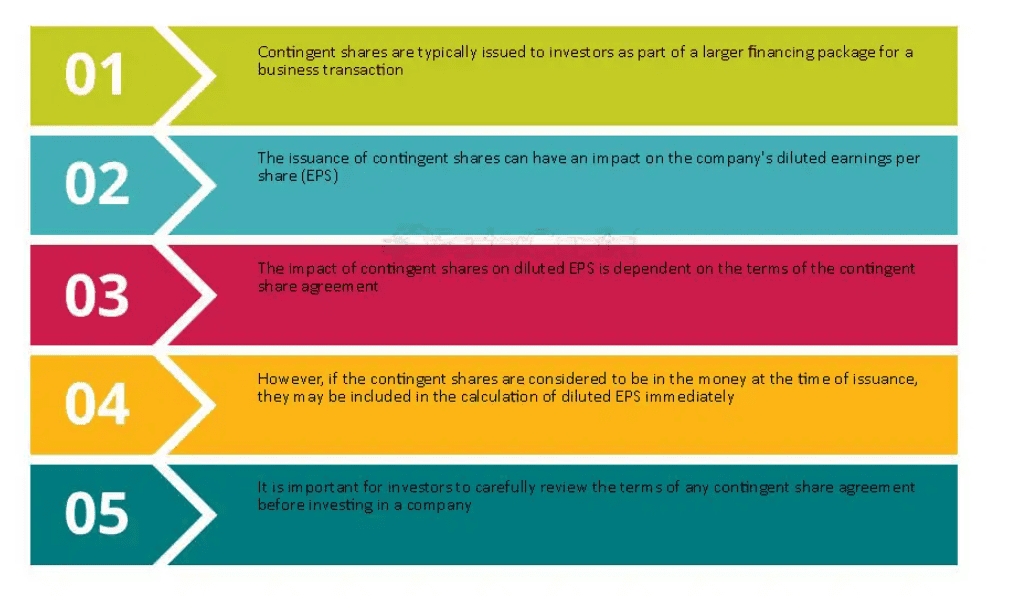Table of contents
Large-scale business decisions like mergers, and acquisitions can include lengthy deal-making and negotiations. One tool that can come into play is something called contingent shares.
Businesses are continually searching for methods to bring the interests of stakeholders together to support the growth and achievement of essential business objectives. At this point, contingent shares are used as a tactic to reward particular accomplishments.
But what exactly are these shares all about? Let’s find out.
What are contingent shares?
If an organisation issues stock to shareholders under exceptional conditions, it is called contingent shares.
They function similarly to regular common stock, except companies issue them upon fulfilment of certain events, such as profitability, meeting earnings targets, or finalising mergers and acquisitions (M&A).
A corporation dilutes the ownership of its current shareholders when it issues contingent shares.
How do contingent shares work?
Buying shares in a company is the same as having a stake in the business. In a private company, those involved in the founding and ownership typically receive shares.
The general public may purchase shares on the primary and secondary markets, where each share represents a certain amount of stock in the business. A 20% ownership position would be holding twenty shares out of a hundred.
Preferred shares give holders preference for dividend payments over other shareholders, while common shares grant holders the right to vote on corporate matters. Next, some are contingently issuable shares.
There is simply one distinction between common shares and contingent shares. Companies hold contingent shares until specific requirements are fulfilled before sending them to the recipient. These circumstances change based on the setting.
Companies often find themselves at odds over a purchase price when they merge. In such a situation, one side might try to close the deal by offering the other side contingent shares.
The intended receivers may get the shares after the transfer of ownership is confirmed. Regardless of the nature of the condition, if it is not satisfied, the shares will be worthless and not issued.

Pros and cons of contingent shares
| Pros | Cons |
| Encourages the accomplishment of certain corporate objectives, such as increasing profitability. | The ownership proportion of current shareholders may be reduced as a result. |
| Brings the interests of shareholders, management, and employees into alignment with one another. | As a result of the distribution of profits among a greater number of shareholders, earnings per share (EPS) are increased. |
| It is useful as a strategy for negotiating in the context of mergers and acquisitions. | The extent to which dilution occurs depends on the specifics of the contingent shares. |
Relationship between contingent shares and diluted EPS
There is no getting around the fact that contingent share issuance affects a company’s earnings per share (EPS). The possible effect of instruments that might be converted into common shares, such as options or convertible bonds, is taken into consideration by diluted EPS, an indicator of a company’s profitability.
The terms and conditions of the contingent share agreement determine the effect of contingent shares on diluted EPS.
Particularly in acquisition scenarios, the acquiring business will issue additional shares to the acquiring business’s shareholders, increasing the total number of shares of the acquired company. The purchasing company’s new share count, which contains the freshly inducted shares, will replace the previous outstanding share count in determining the EPS.
The effect on diluted EPS might be substantial based on the number of contingent shares issued and the probability of getting converted into common shares. The chances of these shares being converted into common shares are higher if the requirements for their issuance are easily satisfied.
Investors get a clearer view of a company’s earnings per share and their possible influence on shareholders by calculating diluted EPS with contingent shares.
Conclusion
We learned how important contingent shares are to corporations and what the pros and cons of issuing them are for both companies and shareholders.
So, while contingent shares may sound like a complex financial instrument, they’re essentially just stock that companies hold in reserve until particular contractual obligations are satisfied. Under the right scenarios, deploying these conditional shares can be a win-win negotiating tactic.
FAQs
In India, contingent shares are not immediately included in the calculation of basic earnings per share (EPS). They become part of the calculation only when the conditions upon which they were issued are met. Once these conditions are satisfied, contingent shares are treated as outstanding and are included in the calculation of basic EPS from the date when the conditions are fulfilled. This ensures that the EPS accurately reflects the company’s financial performance.
An illustrative example of a contingency stock in India could involve a company issuing additional shares to its shareholders if it achieves a certain financial target, such as a specific revenue milestone or a profit threshold. These shares remain dormant until the specific condition is met. This means the shares would only be issued once the specified condition was met, aligning the interests of the shareholders with the financial goals of the company.
A contingent value right (CVR) in India refers to a contractual right that entitles shareholders to additional benefits if certain predefined conditions are met. These rights are often used in mergers and acquisitions to bridge valuation gaps. For example, if the company achieves specific milestones post-acquisition, the shareholders of the target company receive additional compensation. In essence, CVRs improve deal flexibility and allow shareholders to participate in the upside potential of an M&A activity.